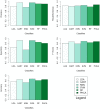Persistent homology classification algorithm
- PMID: 37346603
- PMCID: PMC10280283
- DOI: 10.7717/peerj-cs.1195
Persistent homology classification algorithm
Abstract
Data classification is an important aspect of machine learning, as it is utilized to solve issues in a wide variety of contexts. There are numerous classifiers, but there is no single best-performing classifier for all types of data, as the no free lunch theorem implies. Topological data analysis is an emerging topic concerned with the shape of data. One of the key tools in this field for analyzing the shape or topological properties of a dataset is persistent homology, an algebraic topology-based method for estimating the topological features of a space of points that persists across several resolutions. This study proposes a supervised learning classification algorithm that makes use of persistent homology between training data classes in the form of persistence diagrams to predict the output category of new observations. Validation of the developed algorithm was performed on real-world and synthetic datasets. The performance of the proposed classification algorithm on these datasets was compared to that of the most widely used classifiers. Validation runs demonstrated that the proposed persistent homology classification algorithm performed at par if not better than the majority of classifiers considered.
Keywords: Classification algorithm; Persistent homology; Supervised learning; Topological data analysis.
© 2023 De Lara.
Conflict of interest statement
The authors declare that they have no competing interests.
Figures









References
-
- Alpaydin E. Introduction to machine learning. Third Edition. Cambridge: MIT Press; 2014. (Adaptive Computation and Machine Learning Series).
-
- Carlsson G. Topology and data. Bulletin of the American Mathematical Society. 2009;46(2):255–308. doi: 10.1090/S0273-0979-09-01249-X. - DOI
-
- Carlsson G. Topological pattern recognition for point cloud data. Acta Numerica. 2014;23:289–368. doi: 10.1017/S0962492914000051. - DOI
-
- Charytanowicz M, Niewczas J, Kulczycki P, Kowalski P, Lukasik S, Zak S. A complete gradient clustering algorithm for features analysis of X-ray images
LinkOut - more resources
Full Text Sources
